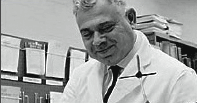DTP Branches and Offices
DTP Profile: Monroe E. Wall (1916-2002)

Dr. Monroe Wall

Monroe Wall (left) and Mansukh Wani (right) observe a beaker of Camptothecin dissolved in chloroform and methanol as it flouresces in UV light.

Mansukh Wani (left) and Monroe Wall (right).

Dried leaves and branches of Taxus brevifolia (left and center), leaves and twigs of Camptotheca acuminata (right).

Taxol®.
Monroe Wall grew up in Newark, New Jersey and earned his B.S., M.S., and Ph.D. at Rutgers University. He joined the U.S. Department of Agriculture (USDA) in 1941, where he researched agricultural sources for products essential to the war effort, such as alternatives to rubber. During the 1950s, most of his research focused on collecting thousands of plant extracts in the search for phytosteroids that could serve as precursors for cortisone. A 1957 visit to USDA by NCI pioneer Jonathan Hartwell, M.D., changed Dr. Wall's focus dramatically. In his role at the Cancer Chemotherapy National Service Center, Dr. Hartwell convinced Dr. Wall to send him 1,000 ethanolic plant extracts to test for antitumor activity. In 1958, an extract from Camptotheca acuminata was found to be particularly potent.
Dr. Wall had little opportunity to pursue this lead until his recruitment by the newly created Research Triangle Institute (RTI) to establish a chemistry program and natural products group. At the new Institute, his experience in isolating small quantities of natural products from plants helped him pioneer techniques for isolating drug metabolites. In the 1970s, he became one of the first individuals to use mass spectroscopy and NMR to obtain the structures of drug metabolites.
Dr. Wall's program in natural products research had not been long in operation when he was given his first sample of leaves, twigs, and bark of the Pacific yew (Taxus brevifolia) in 1964. He and Mansukh Wani, Ph.D., a junior colleague at the time, found and isolated the tree's active ingredient in 1966, and Dr. Wall named it “Taxol.” The two scientists published Taxol's chemical structure in 1971 and promptly turned all their paperwork over to their government contractor, the National Cancer Institute.
During this same period, Dr. Wall produced the sodium salt of Camptothecin, which improved its solubility and allowed it to move into phase I clinical trials. The drug did not progress to phase II trials, however, due to poor solubility and toxicity. The compound continued to be of interest because of its activity against the DNA replication enzyme topoisomerase I.
In 2000, Drs. Wall and Wani were awarded the Charles F. Kettering Prize—the highest honor in the field of cancer research—for their work in isolating chemotherapeutic agents from natural sources. Dr. Wall's many other honors include the Department of Agriculture's Superior Accomplishment Award, the American Pharmaceutical Association's top research prize for natural products chemistry, and the American Society of Pharmacognosy's Research Achievement Award. In 1998, he was awarded the American Chemical Society's Alfred Burger Award, the most prestigious award in medicinal chemistry.
RTI President Victoria F. Haynes, Ph.D., said, “Monroe Wall was one of our founding employees and one of our most outstanding. Through his achievements, such as his work on Taxol and other drugs, he made substantial contributions to improving the human condition.” And C. Edgar Cook, Ph.D., who worked with Drs. Wall and Wani on Camptothecin and later directed the RTI Chemistry and Life Sciences unit that Dr. Wall had founded, described the “Monroe Doctrine” as the basis of Dr. Wall's success: “Get good people, support them with good facilities, do good science, work hard, and keep doing it.”
Dr. Wall's life was in his work, and he was in his laboratory every day until two weeks before his death.





